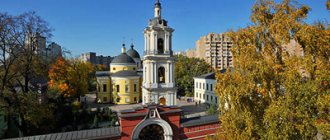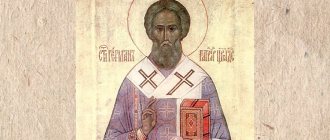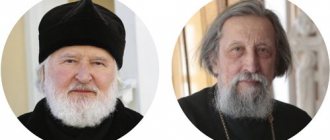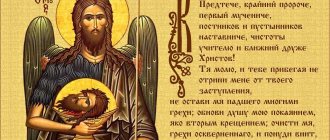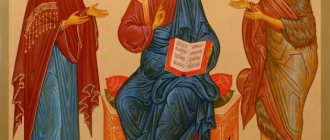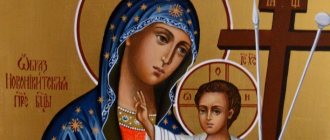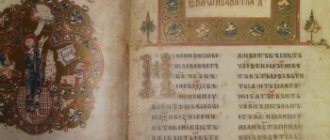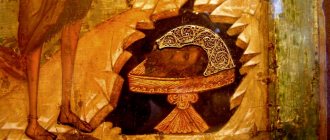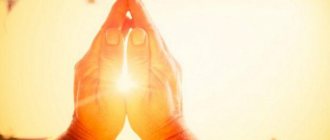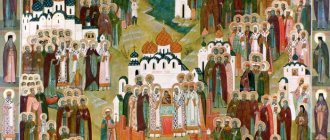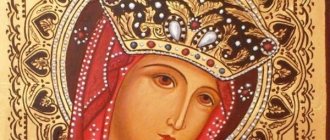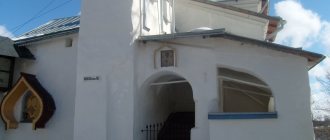Where does a mortal man have wings on the icon?
This widespread image of John the Baptist was called the “Angel of the Desert.”
The wings behind the back of John the Baptist are a symbol of his life as equals with the angels. From the Gospel we know that John lived in a deserted place, dressed in camel skins and ate locusts. According to one interpretation, locusts are the fruits of the carob tree; according to another, an edible variety of locust. — Approx. ed. and wild honey. Reading these lines, we imagine a very harsh, essentially monastic life, which was led by the hermit and ascetic John the Baptist. It is not for nothing that the Church considers him the spiritual patron and forerunner of all monastics. It is no coincidence that the icon we are talking about depicts a desert and a mountain, and in the hands of the Forerunner is a charter. This is what sheets of papyrus were called in ancient times. — Approx. ed. with the inscription: Repent, for the kingdom of heaven is at hand (Matt. 3:2).
Saint John the Baptist Angel of the Desert, c. 1700
And the biblical basis for the angelic iconographic image of John the Baptist is a well-known passage from the book of the prophet Malachi: Behold, I send My angel, and he will prepare the way before Me, and the Lord will suddenly come to His temple (Mal 3 :1). Christ himself directly connected this prophecy with John the Baptist (Matthew 11:10 and Luke 7:27 ).
In the troparion, which is usually read to the monk, there are the following words: “Desert inhabitant and in the body an Angel.” That is, a monk, a reverend, is both an angel and a man; This is the ancient church understanding of the essence of monasticism. It is this similarity with the angelic way of life that is reflected in the icon.
Relative of Christ
The Forerunner was the second cousin of Jesus Christ (his mother, righteous Elizabeth, was a cousin of the Mother of God). The news of his birth, as well as - a little later - of the birth of the Savior, was brought by Archangel Gabriel. “He will be great before the Lord; will not drink wine or strong drink (wine made from fruits and fruits, not grapes - editor’s note) and will be filled with the Holy Spirit from his mother’s womb,” the archangel announced to the father of the future prophet, Zechariah.
John was about six months older than Jesus, so the Church celebrates the Feast of the Nativity of the honest, glorious Prophet, Forerunner and Baptist of the Lord John on July 7 in the new style, exactly six months before the Nativity of Christ.
It is noteworthy that the first meeting of the Messiah and the prophet took place even before their birth. Evangelist Luke speaks about it this way: “When Elizabeth heard Mary’s greeting, the baby leaped in her womb; and Elizabeth was filled with the Holy Spirit, and cried with a loud voice, and said: Blessed are You among women, and blessed is the fruit of Your womb! And where does it come from for me that the Mother of my Lord came to me?” (Luke 1:41-44).
Blessed Theophylact of Bulgaria notes that at this moment the “special gifts” of the Forerunner appeared: “John... plays in his mother’s womb, which is why he is greater than the prophets (Matthew 11:9), for they prophesied after their birth, and he was awarded such a gift being while still in the womb." “Just as they say about prophets that they first came to a supernatural state and were inspired, and then prophesied, so, perhaps, John, as if inspired, first leaped, then prophesied through the mouth of his mother,” he adds.
What amazing theological thought lies behind the image of the “Angel in the Desert”?
The image of the “Angel in the Desert” appears around the 13th century and becomes especially common in the 14th century. In Russia it was written, for example, by Theophanes the Greek. It was precisely at that time that the theological teaching of hesychasm (from the Greek ἡσυχία - silence, silence) took shape, speaking about the possibility of transformation, the deification of man. Saint Gregory Palamas finally formulated the idea expressed back in the 7th century by Maximus the Confessor, that a person is able to enter into direct communication with God through His uncreated energies, is able to see the Light of Tabor.
Sometimes the second head is depicted at the feet of the saint. John the Baptist, Byzantium, mid-15th century.
And according to the Monk Justin (Popovich), who lived quite recently, in the 20th century, the entire gospel of the Old Testament consisted in the fact that man is an icon of God, created in the image and likeness of God (cf. Gen. 1:26 , 27). The gospel of the New Testament sets a new, much higher ideal of the God-man. After the incarnation of Christ, man’s task is not just to keep within himself the image and likeness of God, but to reveal them to the end, to follow Christ and become a God-man. As Saints Athanasius the Great and Irenaeus of Lyon wrote even earlier, God became man in order for man to become god.
The image of John the Baptist, an ascetic and hermit, is perfectly suited to express this idea.
Baptism and beheading
Many believers saw the icon of John in the image of the Baptism of the Lord, where the prophet actually performs his main function of baptizing Christ. However, even after this, John continued to act and preach and suffered martyrdom, just like many of the first Christians.
At that time, King Herod took his brother’s woman as his wife, and this fact was considered bad. Many condemned such cohabitation, and Saint John also did not consider such behavior worthy of a king. Herod himself did not like the reproach, and as a result John was locked up.
Once at a feast, Salome, the daughter of Herodias (Herod’s wife), delighted those present with her dance. She pleased Herod and he ordered to ask for anything, the request was the head of John the Baptist on a platter - an icon depicting this image is also revered in Orthodoxy. The celebration of this day refers to the beginning of the church year and also marks the transition to the era of the New Testament, because after the death of the prophet, who was considered the last, the period of the new Kingdom commanded by Christ began.
The icon of John the Baptist helps every person to successfully cope with any work and fulfill his duty with dignity!
Throughout the year there are many days of veneration of the icons of St. John:
- October 6 - conception of John the Baptist;
- July 7 - Nativity of the Prophet;
- September 11 - beheading;
- March 9 - in memory of the first and second finding of the head;
- June 7 - the third discovery of the head of the prophet.
“Truly I say to you, among those born of women there has not arisen a greater man than John the Baptist; but he who is least in the kingdom of heaven is greater than he.” (Matt. 11:11).
John the Baptist, prophet; Russia. Kievan Rus; XIV century; location: USA. Houston (Texas). Menil Collection; material: wood, gold (leaf). John the Baptist, John the Baptist (6-2 BC - c. 30 AD) is the last in the line of Old Testament prophets - the harbingers of the coming of the Messiah. Revealed Jesus Christ to the chosen people as the Messiah-Savior, who baptized Jesus Christ. According to the Gospels, he lived in the desert as an ascetic, preached and performed sacred ablutions for the cleansing of sins and repentance of the Jews. John the Baptist; XIV century; Byzantium. Athos - Orthodox Russian Icon workshops. Sacred ablutions subsequently became known as the sacrament of baptism. Having baptized Jesus Christ in the waters of the Jordan River, dipping Him into the water three times. John the Baptist was beheaded at the request of the Jewish queen Herodias and her daughter Salome. John the Baptist (Baptist) is a historical figure mentioned in the manuscripts of Josephus' Antiquities of the Jews. These tests are considered authentic and not later additions by Christian scribes.
Annunciation by an Angel of the Birth of John the Baptist.
Zechariah and Elizabeth (Nativity of John the Baptist). XV century, Russia. During the reign of Herod, king of the Jews, the priest Zechariah and his wife Elizabeth lived a righteous life in the city of Hebron. They did not have children, which the Jews considered God's punishment for sin. In childlessness, Zechariah and Elizabeth lived to such an advanced age when there was no longer any hope of having children. But one day, when Elder Zechariah was serving in the Jerusalem temple, an Angel appeared to him and “...said to him: Do not be afraid, Zechariah,” said the Angel, “for your prayer has been heard, and your wife Elizabeth will bear you a son, and you will call his name John.” ; and you will have joy and gladness, and many will rejoice at his birth; for he will be great before the Lord; He will not drink wine or strong drink, and will be filled with the Holy Spirit from his mother’s womb; and he will turn many of the children of Israel to the Lord their God; and he will go before Him in the spirit and power of Elijah, to restore the hearts of the fathers to the children, and to the disobedient the way of thinking of the righteous, in order to present to the Lord a prepared people” (Luke 1:13-17). The Gospel of Zechariah. Fragment of an icon, 17th century. Amazed and delighted by the words of the Angel, “Zechariah said to the Angel: How do I know this? for I am old, and my wife is advanced in years” (Luke 1:18). “The angel answered him: I am Gabriel, who stands before God, and was sent to speak with you and bring this good news to you; and behold, you will remain silent and will not be able to speak until the day these things happen, because you did not believe my words, which will come true in due time” (Luke 1:19-20). Having said this, the Angel disappeared, and Zechariah at that very moment became dumb. Having finished serving in the temple, Zechariah returned, and Elizabeth, despite her age and previous infertility, conceived. Elizabeth hid her pregnancy from people for five months. Archangel Gabriel, who announced to Zechariah about the birth of his son, preaching to the Most Holy Virgin Mary about the birth of Christ the Savior from Her, revealed to Her that “Here is Elizabeth, Thy relative, who is called barren, and she conceived a son in her old age, and she is already in her sixth month ,” (Luke 1:36). Hearing about the joy that was being prepared for Elizabeth, the Most Holy Virgin, who had already conceived the Son of God, hastened to visit her. “When Elizabeth heard Mary’s greeting, the baby in her womb leaped; and Elizabeth was filled with the Holy Spirit” (Luke 1:41).
Nativity of John the Baptist.
Nativity of John the Baptist. Elizabeth, in accordance with the Angel's prediction, gave birth to a son. On the eighth day from John’s birthday, according to the law of Moses, the baby had to be circumcised and given a name. According to Jewish custom, the relatives, who knew nothing about the fact that the name of the baby had already been indicated by the Angel even before his conception, wanted to name the newborn by the name of his father, i.e. Zechariah. Nativity of St. John the Baptist. Icon. End of the 16th - beginning of the 17th century. But Elizabeth did not agree. Then they asked Zechariah with signs. “He demanded a tablet and wrote: John is his name. And everyone was surprised. And immediately his mouth and his tongue loosened, and he began to speak, blessing God. He demanded that they bring him a tablet, and wrote on it: “John is his name” (Luke 1, 63-64). From that time on, Zechariah’s tongue was resolved, and he began to bless God and prophesy about the imminent coming of the Messiah Christ and that John would be His Forerunner: “And you, little child,” said Zechariah, turning to his son, “thou shalt be called a prophet of the Most High, for You will come before the face of the Lord to prepare His ways” (Luke 1:76).
The early years of John the Baptist.
John the Baptist Angel of the Desert, with a life in 18 brands. Around 1700. Moscow. School of royal isographers. From a young age, John chose an unusual way of life - he retired to the uninhabited Judean desert, settled in a wild cave and stayed in it until the thirtieth year of his life, indulging in prayer and pious meditation, constantly talking with the One God. He wore simple, stiff clothes, made of camel hair, girdled with a leather belt. He ate plant roots, wild honey and locusts. Living in the depths of the desert, John the Baptist waited for the Lord to call him to the work of public service.
Sermons of John the Baptist about the Coming of the Messiah.
The stone from which John the Baptist preached. When John was thirty years old, the voice of God commanded him to leave the desert, go to the Jewish people and, by preaching repentance and baptism, encourage the people to repent of their sins: since the time had come for the coming of the Messiah. Obeying the heavenly voice, John appeared on the banks of the Jordan River in the Judean desert. People began to flock to him. John the Baptist preaches “and says: Repent, for the kingdom of heaven is at hand. For he is the one about whom the prophet Isaiah said: the voice of one crying in the wilderness: prepare the way of the Lord, make his paths straight.” (Matt. 3:2-3). In order for people to more clearly understand how they need to get rid of their vices, John the Baptist gave instructions to each class separately. And to stingy people, and to selfish people, and to publicans (tax collectors), and to soldiers. John knew how to clearly and understandably convey to everyone the great commandment: “love your neighbor as yourself.”
But in addition to ordinary people, people who enjoyed great respect among the people also came to John - the Pharisees and Sadducees. The Pharisees were people who were proud of their imaginary holiness: they were strict followers of the law, they prayed loudly in the streets, they gave out alms in the squares, but their hearts were filled with vanity, envy and deceit; they dreamed that, like natural children of Abraham, they would necessarily enter the Kingdom of the Messiah. The Sadducees are unbelievers, characterized by free-thinking: they rejected the existence of the spiritual world and therefore did not believe in the existence of Angels, in the afterlife and the torment and bliss awaiting there. “John said to the people who came to be baptized by him: you are brood of vipers! who inspired you to flee from future wrath? Produce fruits worthy of repentance and do not think of saying within yourself, “We have Abraham as our father,” for I tell you that God is able to raise up children for Abraham from these stones. Even the ax lies at the root of the trees: every tree that does not bear good fruit is cut down and thrown into the fire.” (Luke 3:7-9). Many residents of Judea and Jerusalem came to John the Baptist and were baptized by him in the Jordan, confessing their sins. The influence of sermons and baptism was so great that people secretly began to wonder if John was Christ? “John answered everyone: I baptize you with water, but one stronger than me is coming, whose sandal strap I am not worthy to untie; He will baptize you with the Holy Spirit and fire." (Luke 3:16). With these words, John answered that he was not Christ, but only His servant and Forerunner.
John the Baptist Baptizes Jesus Christ.
Icon of the Baptism of the Lord. 15th century icon belonging to an icon painter from the circle of Andrei Rublev. “Christ did not need baptism, either this (John’s) or any other; or better yet, baptism needed the power of Christ” (St. John Chrysostom). For six months already, John the Baptist preached repentance and baptized the Jews who came to him, “then Jesus comes from Galilee to the Jordan to John to be baptized by him.” (Matt. 3:13). The One about whom John preached came. Jesus of Nazareth John knew Jesus as the son of Mary, as his relative according to the flesh, and knew about the extraordinary purity and holiness of the life of Jesus. The Holy Spirit, which overshadowed John from his mother’s womb, at the appearance of Jesus, illuminated his soul with a special, heavenly light and aroused in his heart something that John had not felt before. John felt that Jesus of Nazareth, standing before him, was his Lord and God, the Lord of heaven and earth, the true light that enlightens every person. John heard that Jesus demanded baptism from him. “John restrained Him and said: I need to be baptized by You, and are You coming to me?” (Matt. 3:14). Jesus entered the Jordan River. “And having been baptized, Jesus immediately came out of the water, and behold, the heavens were opened to Him, and John saw the Spirit of God descending like a dove and descending on Him. And behold, a voice from heaven said: This is My beloved Son, in whom I am well pleased.” (Matthew 3:15-17). This is how the baptism of our Lord Jesus Christ took place by the hand of the holy Prophet, Forerunner and Baptist John in the waters of the Jordan and the discovery for John the Baptist of the Divinity of Jesus Christ, the promised Messiah. John was convinced of the divine worth of Jesus with his own eyes: “I did not know Him; but He who sent me to baptize in water said to me: On whom you see the Spirit descending and remaining on Him, He is the one who baptizes with the Holy Spirit. And I have seen and testified that this is the Son of God.” (John 1:33-34). Subsequently, all the sermons of John the Baptist were devoted to testifying to the Divinity of Jesus Christ, as the Son of God, as the Lamb who took upon Himself the sins of the whole world, as the Messiah who came to open a new spiritual kingdom.
John the Baptist is the Voice of the One Crying in the Desert.
Even after the baptism of Jesus Christ, many people continued to see the Messiah in John himself, since the humble image of Christ the Savior did not conform to Jewish concepts of the greatness of the Messiah. The elders of the Jewish people sent an embassy of priests and Levites to John to ask who John was? John declared: “I am not the Christ.” (John 1:20). Since many of the Jews believed that before the coming of the Messiah Elijah would appear on earth, then: “And they asked him: what then? are you Elijah? He said no. Prophet? He answered: no." (John 1:21). Hearing this firm answer from John, the messengers “said to him: who are you? so that we can give an answer to those who sent us: what do you say about yourself? He said, “I am the voice of one crying in the wilderness: straighten the way of the Lord, as the prophet Isaiah said.” (John 1:22-23). Elijah the Prophet: outwardly depicted as similar to John - a lion's mane of hair, a hair shirt made of camel skin. Then the messengers asked John: “Why are you baptizing if you are not Christ, nor Elijah, nor a prophet?” (John 1:25). “John answered and said unto them, I baptize with water; but there is Someone standing among you whom you do not know. He is the one who comes after me, but who stands in front of me. I am not worthy to untie the thong of His sandals. (John 1:26-27).
John the Baptist - “Friend of the Groom...”, the last testimony of the Forerunner.
“The next day John sees Jesus coming to him and says: Behold the Lamb of God, who takes away the sin of the world. This is the one of whom I said: A man comes after me, who stood before me, because He was before me. I didn't know Him; but for this reason he came to baptize in water, so that He might be revealed to Israel. (John 1:29-31). John fully and clearly revealed the Divine dignity of Jesus Christ to his disciples. But John’s disciples complained to him that Jesus, whom he baptized and who, instead of honoring the Baptist as His teacher, gathered his own disciples and began to baptize. John points out to them that Jesus begins to baptize “through His disciples” (John 4:2). And further, “John answered and said: A man cannot take upon himself anything unless it is given to him from heaven.” (John 3:27). “You yourselves are my witnesses of this, that I said: I am not the Christ, but I was sent before Him” (John 3:27). John uses a comparison in which he likens Christ to the groom, his followers to the bride, and calls himself the friend of the groom: “He who has the bride is the groom, and the friend of the groom, standing and listening to him, rejoices with joy, hearing the voice of the groom. This is my joy fulfilled. He must increase, but I must decrease.” (John 3:29-30).
“...He who comes from heaven is above all,...for He whom God has sent speaks the words of God; For God does not give the Spirit by measure. The Father loves the Son and has given everything into His hand. He who believes in the Son has eternal life, but he who does not believe in the Son will not see life, but the wrath of God remains on him.” (John 3:31-36). This was John's last testimony about Jesus Christ. Three disciples of John the Baptist followed Jesus; these were the future apostles: - Andrew, called the First-Called; - John, beloved disciple of the Lord; - Peter. Their great teacher John the Baptist was soon imprisoned, and sent his remaining disciples to Jesus so that the disciples would be convinced of His Divine dignity as the Messiah. By this John once again showed his fidelity to the goal of his great ministry. The Savior, in His response to John, adorned him with such great praises as no man had ever received. “Truly I say to you, among those born of women there has not arisen a greater man than John the Baptist; but he who is least in the kingdom of heaven is greater than he.” (Matt. 11:11).
The murder of the Forerunner of Christ.
The beheading of John the Baptist. John was imprisoned by the Galilean ruler Herod Antipas. Herod Antipas had great respect for John. He consulted with John when making government decisions and talked with him with pleasure. Contrary to the law of God, Herod married Herodias, the wife of his still living brother Philip, driving away his lawful wife, the daughter of Aretas, the ruler of rocky Arabia. John, a strict keeper of the law, a zealot of truth and piety, raised his voice against such lawlessness, “For John said to Herod: You must not have your brother’s wife” (Mark 6:18). “Herodias, angry at him, wanted to kill him; but I couldn’t.” (Mark 6:19). But soon this Herodias found a way to take revenge. At his birthday, Herod was so amazed by the dance of Salome, the daughter of Herodias, that he said to her: “Ask me whatever you want, and I will give it to you”; and with an oath he added: “Whatever you ask of me, I will give you, even up to half of my kingdom” (Mark 6:22-23). Salome, at the instigation of her mother, demanded the head of John the Baptist. And Herod, weak in character, for fear of appearing to be a liar before others, agreed to the murder of the Forerunner of Christ. Herod's squire cut off John's head and presented it on a platter to the maiden Salome, who gave the severed head to her mother. In memory of this, a church holiday was established - the Beheading of John the Baptist.
